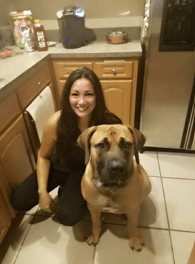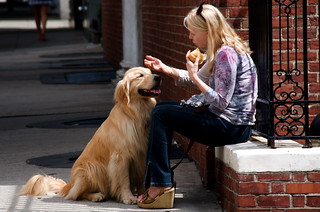The other day when I mentioned feeding raw dog food to a lady who’s dog had just been diagnosed with diabetes, she nearly fell off the chair in horror! “You can’t feed raw meat to a dog…. it’s dangerous!”
When I asked why, she was not quite as sure of what to say for a moment and then as the answer formed in her mind she began to tell me things she had heard from someone else. I got the “because it’s got dangerous bacteria in it and if there’s bones, they’ll get stuck and I don’t want my dog to die” after that she stopped as if her brain had been automatically shut off with a preset auto answer limiter.
There were many replies floating around in my head but these days I generally stay quiet and let people come to me with their last minute cries of help to fix the unfixable.
I thought of how dogs lick, eat, play with and generally get involved with some pretty disgusting stuff during their daily lives, all of which is laden with bacteria and none of it of any consequence to a dog’s powerful digestive system. I also thought of all the false information planted in peoples heads by vets either un-whitingly, by deception or just plain ignorance…. or perhaps greed!
I even thought of the bone argument, so beloved by those who do not see (as in James Camerons Avatar “I see you”) and how that story gets mangled and thrown around for the un-wary to fear such non-sense when all commercial dog food plain kills dogs off by age 12.5 as per the official data when that festering, bone riddled piece of meat means a life lived to a third longer!
Boy how nature gets a bad rap these days?
I want to help dogs more than anything in the world and am prepared to do as much as I can but it’s the humans getting in the way that holds the healing process up. Boy do we have a lot to re-learn about dogs and what they need to eat for true health.
Chemical Effects of Feeding Your Dog Raw Food
The “fuel” or food a dog eats when it’s raw needs to provide the energy for growth, maintenance and repair. If the quantity, quality and frequency of intake of the chemical constituents are optimal this will be reflected in optimum health, vitality and longevity.
How can we be sure of the chemical requirements of dogs?
The answer is straightforward, nature knows best. More than 3.5 billion years ago the origen of life began and through the evolution of mammals 200 million years ago, up to the present time, the food of species is defined by that which is consumed in nature. For carnivores and hence our dogs this means almost any mammal, amphibion, reptile, fish or bird capable of being overpowered and killed.
Wild dogs, long standing traditional ones like Dingo’s and also the cuddly hosehold dogs gone astray and turned wild will catch, kill and consume rabbits, birds, young sheep and goats, tear them apart, bolt chuncks of meat down and pick at the stomach contents for extra herbage. The bulk of the meal is meat, bone and offal (internal organs like heart, lungs, liver and intestines).
No one knows the chemical makeup of such a diet, it’s impossible for scientists to analyse because the very act of extracting delicate biochemicals by heating and solvent extraction leads to the destruction of the biochemicals. Of course dogs don’t need to know as they get on with their inate instinctive knowledge of what constitutes a balanced diet…. the wild ones anyway.
Meanwhile, the immune system keeps a watchful eye on the whole digestive process ready to deal with those bad bacteria the lady above is so scared of… don’t worry natures got it covered comes to mind, always has.
Chemical Effects of Cooked Food on Dogs
Cooking alters both the physical and chemical makeup of food. Where the raw item provides the correct quantity and balance of proteins, fats, carbohydrates, vitamins, minerals and micronutrients, the cooked version does not. Generally the greater the heat and the longer the duration of heating the greater the damage to the fragile biochemicals. This makes them un-bioavailable which means they cannot be as much use the the dogs body in their damaged state.
Heated proteins coagulate and the constituent amino acids are often destroyed. And its this change in vital protein structure that leads to allergies in dogs.
Cooked fats become significantly altered at the biological level even to the extent of becoming toxic. The correct balance of long chain and short chain fats is essential to good health but once the meat is cooked the balance of fats changes.
Complex carbohydrates such as starch are not part of the chemical makeup of dogs. Grains so beloved by dog food manufacturers for their cheap supply hardly register as part of a dogs nutritional requirements.
Perhaps even more importantly, the effect of cooking on delicate vitamins and micronutrients including antioxidants are pretty much completely detroyed.
Minerals in cooked food become less bio-available. The dog has evolved to consume large amounts of bone and it’s high levels of calcium. The calcium is offset by the high levels of phosphorous content in raw meat. However once bones are cooked the bio available calcium is reduced and the brittle hardened bones can penetrate the bowel or get stuck anywhere from the mouth to the anus.
One of the worst aspects of cooked food is the absence of biologically active cellular enzymes. All cells whether plant or animal conytain enzymes. When raw cells are crushed and the enzymes released into tissues rapid chemical digestion takes place reducing complex proteins, fats and carbohydrates to their constituent parts. The stomach contents of a raw meal is soon reduced to a slurry before pancreatic digestive juice is added further along the digestive system to complete the digestion process.
Contrast This With Cooked Food…
The cellular enzymes are already dead from the heating process and so no auto-digestion can take place. While cooking may reduce some proteins to their constuent amino acids, the process does not continue in the stomach to any great extent. As the food moves further along the digestion process the pancreas has to release far greater quantities of enzymes which results in a complete change of microenvironment in the bowel and thus the rate of digestion.
Slow and poorly digested food tends to damage the bowel lining. Mostly this is as a result of changed resident population of bacteria. Harmful bacteria and ther toxins affect the lining of the bowel and if absorbed into the bloodstream are harmful to other organs. And when harmful bacteria increase the good bacteria decrease.
So the perception that feeding a raw piece of meat covered in dirty bacteria to your dog is dangerous while the squeeky clean canned and bagged stuff is somehow clean and safe acutually represents the complete opposite of whats happens in the dogs bowel.
 Like the woman at the beggining of this article, thousands of dog owners are struggling with sick dogs eating cooked food and suffering from intestinal bacterial overgrowth which is slowly killing them and all because they cannot “see” natures power any more.
Like the woman at the beggining of this article, thousands of dog owners are struggling with sick dogs eating cooked food and suffering from intestinal bacterial overgrowth which is slowly killing them and all because they cannot “see” natures power any more.
Look at that big guy in the photo looking up. He was a sick dog until the lovely lady with him, did something about it and switched him to a raw food diet.
Do your dog a favor and feed them a raw dog food diet. If you can’t do that then just try adding in some fresh food likes part cooked and mashed veggies. You’ll be surprised at how much difference that makes.







i had a male westie ,he was fed on james beloved dry food .had no problems with anal glands and lived for 17years and 3months.
Excellent, thanks for sharing. Just goes to show, sometimes dogs are just fine on the basics.
the link did not work i could not access the guide that was sent to my email 🙁
I have emailed you the guide Jill.